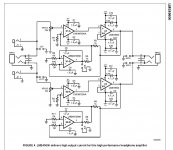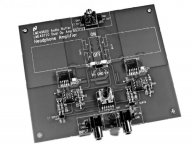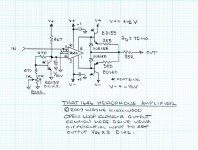Application Information
HIGH PERFORMANCE, HIGH FIDELITY HEADPHONE
AMPLIFIER
The LME49600 is the ideal solution for high output, high performance
high fidelity head phone amplifiers. When placed in
the feedback loop of the LME49710, LME49720 or
LME49740 High Performance, High Fidelity audio operational
amplifier, the LME49600 is able to drive 32Ω headphones to
a dissipation of greater than 500mW at 0.00003% THD+N
while operating on ±15V power supply voltages.
HIGH PERFORMANCE, HIGH FIDELITY HEADPHONE
AMPLIFIER
The LME49600 is the ideal solution for high output, high performance
high fidelity head phone amplifiers. When placed in
the feedback loop of the LME49710, LME49720 or
LME49740 High Performance, High Fidelity audio operational
amplifier, the LME49600 is able to drive 32Ω headphones to
a dissipation of greater than 500mW at 0.00003% THD+N
while operating on ±15V power supply voltages.
Attachments
multiloop topologies are likely the quickest way to really low distortion
for output gain/current buffering the TPA6120 is pretty good on the raw specs and being a CFA you can keep its corner frequency high enough that the input op amp dominant pole controls stability
Iv'e used a high quality fet input op amp like OPA627 with its feedback wrapped around the TPA6120
I've also biased the TPA6120 into push-pull Class A
post #3:
http://www.diyaudio.com/forums/solid-state/45794-high-loop-gain-composite-op-amp-circuits.html
for output gain/current buffering the TPA6120 is pretty good on the raw specs and being a CFA you can keep its corner frequency high enough that the input op amp dominant pole controls stability
Iv'e used a high quality fet input op amp like OPA627 with its feedback wrapped around the TPA6120
I've also biased the TPA6120 into push-pull Class A
post #3:
http://www.diyaudio.com/forums/solid-state/45794-high-loop-gain-composite-op-amp-circuits.html
Application Information
HIGH PERFORMANCE, HIGH FIDELITY HEADPHONE
AMPLIFIER
The LME49600 is the ideal solution for high output, high performance
high fidelity head phone amplifiers. When placed in
the feedback loop of the LME49710, LME49720 or
LME49740 High Performance, High Fidelity audio operational
amplifier, the LME49600 is able to drive 32Ω headphones to
a dissipation of greater than 500mW at 0.00003% THD+N
while operating on ±15V power supply voltages.
yes, with a unity gain for both the op amp and the buffer at 1khz.
with a 20db gain, distorsion will be 0.0003% at 1khz and
dramaticaly increasing at 10khz, that is, no better than the
vintage 5532.
Beware of the marketing optimized figures..
also, the distorsion is specified in a 80khz bandwith, while
the figures i quote with the ne5532 + bjts are for a 5mhz bandwith..
What about the total cost using the NS circuits?..
A NE5532 + a pair of darlingtons is about $3....
looks like i will be of to my local electronics store and getting some NE 5532s and transistors.
I have power transformers already for the psu, and im going to go regulated as well.
I have power transformers already for the psu, and im going to go regulated as well.
This headphone amp caught my interest earlier today......
HeadWize: DIY Workshop > THAT1646 Headphone Amplifier
THAT1646 + BD139/BD140.... Class-A.
I wonder if a DRV134 could be used instead?
HeadWize: DIY Workshop > THAT1646 Headphone Amplifier
THAT1646 + BD139/BD140.... Class-A.
I wonder if a DRV134 could be used instead?
Attachments
Im not a massive fan of class A, due to the introduction of thermal noise.
If the active devices are a cool that means less thermal noise.
If the active devices are a cool that means less thermal noise.
TO-263s are big by surface mount standards. I wouldn't worry about it.Shame its bloody surface mount 🙁
This appears to be in reference to THD+N, not the THD component thereof. In which case it's correct, albeit somewhat confusing, if the noise gain is also 20dB.with a 20db gain, distorsion will be 0.0003% at 1khz
Last edited:
This appears to be in reference to THD+N, not the THD component thereof. In which case it's correct, albeit somewhat confusing, if the noise gain is also 20dB.
The figure is for a relatively high output level at which noise
is much less than THD.
Increasing by 20dB the gain of the op amp that drive the unit
will yield the same increase in distorsion as the available negative
feedback will be reduced proportionaly, so even if noise is increased
by 20db, THD will still be prominent.
Im not a massive fan of class A, due to the introduction of thermal noise.
If the active devices are a cool that means less thermal noise.
When talking a high gain small signal amp, thermal noise at the input can be important. OTOH, any contributions from the output shouldn't amount to anything, and will be reduced by feedback to a large degree. IMO, thermal noise is only an issue if it gets amplified by subsequent stages. A headphone amp seems like the one place that class A makes sense, though I don't think it has any real advantage over some of the low distortion schemes above. BTW, I like my headphone amps to have a low Z output, but apparently many 'phones are designed for something like 32 ohms output.
Best,
Conrad
yes, with a unity gain for both the op amp and the buffer at 1khz.
with a 20db gain, distorsion will be 0.0003% at 1khz and
dramaticaly increasing at 10khz, that is, no better than the
vintage 5532.
Beware of the marketing optimized figures..
also, the distorsion is specified in a 80khz bandwith, while
the figures i quote with the ne5532 + bjts are for a 5mhz bandwith..
What about the total cost using the NS circuits?..
A NE5532 + a pair of darlingtons is about $3....
I think I know what your getting at, below is a pic of buf634(basically an lme49600) headphone driver at a gain of +21 with related THD+N figures,bit different to the unity gain figures of lme49600.
Attachments
hi, shark70
The gain of this one is 24.44db, which is quite high, therefore,
the distorsion is somewhat significantly higher than with a 49710 + 49600
used in an unity gain scheme..
Also, the opa132 has not as good distorsions figures as a 49710,
and is even inferior to a 5532 if the input impedance of the buffer is
not high enough, not counting that it has double the noise of a 5532
and 3.5 folds the one of the 49710.
49710 or even 5532 would do it better to drive the BUF634 which seems
himself inferior as a 49600 in matter of maximum output current, as
the load is displayed as a 100 ohm one.
Anyway, a lot of solutions exists, and it s a matter of performance/price
ratio.( and also of psychologicaly influenced taste..)
Using cheap op amp + darlingtons allow a low cost circuit with no compromise
in perfs, as it got a current capability than no integrated buffer can match
at a reasonable price, and very low distorsion because the driving op amp is very
lightly loaded.
The gain of this one is 24.44db, which is quite high, therefore,
the distorsion is somewhat significantly higher than with a 49710 + 49600
used in an unity gain scheme..
Also, the opa132 has not as good distorsions figures as a 49710,
and is even inferior to a 5532 if the input impedance of the buffer is
not high enough, not counting that it has double the noise of a 5532
and 3.5 folds the one of the 49710.
49710 or even 5532 would do it better to drive the BUF634 which seems
himself inferior as a 49600 in matter of maximum output current, as
the load is displayed as a 100 ohm one.
Anyway, a lot of solutions exists, and it s a matter of performance/price
ratio.( and also of psychologicaly influenced taste..)
Using cheap op amp + darlingtons allow a low cost circuit with no compromise
in perfs, as it got a current capability than no integrated buffer can match
at a reasonable price, and very low distorsion because the driving op amp is very
lightly loaded.
Last edited:
Mmm thanks for your input wahab.
I went to my local electronics store today and for 9.95 each (bargain) i picked up two TDA 2822 amp modules that are capable of pushing nearly a watt into 8 ohms. Very low parts count. I am still thinking of your method though, but as im a bit broke at the moment, i intend of building a system that will allow a modular approach that will allow me to swap amps at will with the same inputs and same headphones, just to see which amps sound better.
Since im using them for positional audio (computer games) low distortion and good bandwidth is essential.
I went to my local electronics store today and for 9.95 each (bargain) i picked up two TDA 2822 amp modules that are capable of pushing nearly a watt into 8 ohms. Very low parts count. I am still thinking of your method though, but as im a bit broke at the moment, i intend of building a system that will allow a modular approach that will allow me to swap amps at will with the same inputs and same headphones, just to see which amps sound better.
Since im using them for positional audio (computer games) low distortion and good bandwidth is essential.
Not wanting to cool down your enthusiasm,but if my memory is good ,
the TDA2822 IS a low perfs version of the TEA2025 from the same
manufacturer , STmicro....
the TDA2822 IS a low perfs version of the TEA2025 from the same
manufacturer , STmicro....
ahh crap.
The TEA 2025 isnt anything special either, so the 2822 is probably worse.
Looks like im going your way wahab!
Might set up a parts list and get it all today.
The TEA 2025 isnt anything special either, so the 2822 is probably worse.
Looks like im going your way wahab!
Might set up a parts list and get it all today.
This headphone amp caught my interest earlier today......
HeadWize: DIY Workshop > THAT1646 Headphone Amplifier
THAT1646 + BD139/BD140.... Class-A.
I wonder if a DRV134 could be used instead?
That is very amazing. Well worth building. I didn't check the DRV134 data sheet, but I believe that the design is THAT1646 specific. I prefer the THAT part regardless.
Last edited:
For anyone interested in the LME49600 National reference design in this thread, I'm going to be spinning a DIY-friendly PCB, taking measurements, etc. Before I go too far, I'm trying to get an idea if there's interest in a group buy of boards? If you might be interested, please see this post:
LME49600 Headphone Amp Design
LME49600 Headphone Amp Design
again multiloop op amp topologies betters both the self heating noise/thermal feedback and the reduced gain issues - use a CFA op amp for output with local gain equal to the final amp gain - then the (unity gain stable) input op amp can be selected for low noise, doesn't have to drive anything except the CFA + input @ MOhm||pF - can even use sub regulated power supplies
TPA6120 is really good, fast enough to allow most <10-20 MHz GBW input op amps to run stably in "unity gain" with the TPA adding loop gain
for thru-hole/easy heatsinking the LT1206/10 are CFA in TO-220
"unmeasurable" distortion is pretty easy to achive with just a few op amps for ~ +/-12 V, 200-400 mA peak drive that covers most dynamic headphone loads - you can bridge for the few requiring higher V drive
I agree smt, high frequency layout, bypass decoupling requirements of the best CFA like the TPA6120 do add to the complexity - but I think riding on the advanced isolated, complementary bipolar semi processing and development $, deep expertise of the A/DSL op amp designers is worthwhile - no audio "guru" has near the resources, institutional knowledge or budget that these chip designers do
TPA6120 is really good, fast enough to allow most <10-20 MHz GBW input op amps to run stably in "unity gain" with the TPA adding loop gain
for thru-hole/easy heatsinking the LT1206/10 are CFA in TO-220
"unmeasurable" distortion is pretty easy to achive with just a few op amps for ~ +/-12 V, 200-400 mA peak drive that covers most dynamic headphone loads - you can bridge for the few requiring higher V drive
I agree smt, high frequency layout, bypass decoupling requirements of the best CFA like the TPA6120 do add to the complexity - but I think riding on the advanced isolated, complementary bipolar semi processing and development $, deep expertise of the A/DSL op amp designers is worthwhile - no audio "guru" has near the resources, institutional knowledge or budget that these chip designers do
Last edited:
- Status
- Not open for further replies.
- Home
- Amplifiers
- Chip Amps
- Designing a super low distortion headphone amp.



